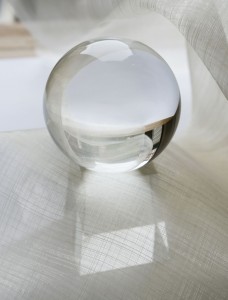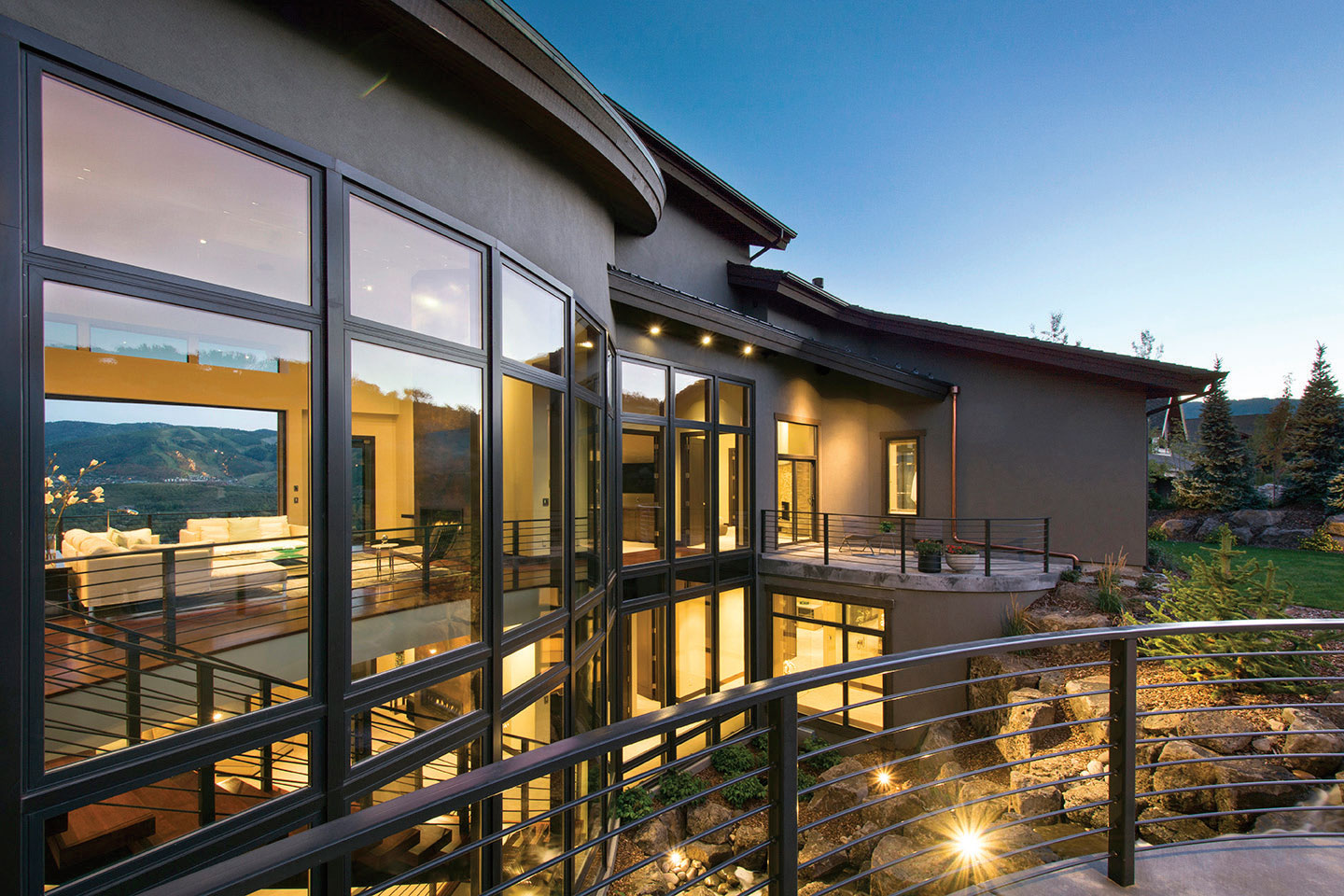CLEARLY A GREAT MATERIAL
MOUNTAIN HOMES BENEFIT FROM ADVANCES IN GLASS TECHNOLOGY
More mountain homes these days feature exciting and innovative uses of glass, and glass producers are making products that save energy and aesthetically enhance homes in unexpected new ways. So often, as with glass, advances in building materials work hand-in-hand with design as new building materials inspire designs that push the envelope, and bold new designs demand more from the material suppliers and installers. Mountain climate extremes previously limited the use of glass, but now products address strident energy requirements, and artful new uses of glass are appearing that were imagined a hundred years ago but not available.
INDUSTRIALIZING A SKILLED CRAFT
There is something decidedly modern about big glass, although glass windows have been around since well before the Roman Empire. It wasn’t until the 17th century that glass became common in homes, and then and into much of the 19th century, glass was hand-blown and expensive. Hand-formed pieces were mounted together in panes for larger windows. The initial glass recipe was pure silica (sand) melted in furnaces at high temperatures along with additions that changed the melting characteristics and qualities of the glass like sodium carbonate, lime, iron, and various metal oxides.
The Industrial Revolution pushed machine-manufactured glass production forward and increased its size, uniformity, strength, and affordability. As early as 1914, Bruno Taut created the glass pavilion, marvelous even for today, with a multi-hued prismatic glass dome and a glass-treaded metal staircase. It inspired Paul Scheerbart to write a famous treatise on glass in architecture, Glasarchitektur. The inspiration took, and glass and metal soon became synonymous with modern architecture. However, products to implement the vision of glass in homes didn’t stand up to the dream. One of the most endearing mid-century modern American homes is glass-walled—the Farnsworth House (1945–51), designed by Ludwig Mies van der Rohe in Plano, Illinois. However, even the iconic Farnsworth home receives criticism for discomfort with winter heat loss and too much summer heat gain. Improving the thermal qualities of glass isn’t the only obstacle to using glass in homes. As any kid drying the family’s best water glasses knows, glass is fragile, and glass shards are sharp and dangerous. So, how did glass make the leap to becoming an accepted building material that is propelling design to new levels?
WINDOWS: IT’S ALL ABOUT THE VIEWS

“The best thing about our climate is so much sunshine, and a design challenge is trying to control the associated solar gain and heat loss,” observes Salt Lake City architect James Carroll, a frequent collaborator with Gardner Group.
With ordinary windows, up to 87% of heat gain and 49% of heat loss occurs (According to the Glass and Glazing Institute of Australia). The glass and window industry responded by engineering new products first to address the energy crisis in the 1970s and then again to help the sustainable green building movement and adhere to Europe’s strict energy standards for greenhouse gas emissions. The result: better performing and even bigger windows. Current home designs require an energy analysis. Where energy is lost, other components of the design like more insulation or higher efficiency heating and cooling systems must compensate. This can limit the use of windows or raise costs.
“Current residential codes require a maximum of .35 U-value for windows,” explains James Carroll. “Great strides continue to be made, and newer glass has better U-values and also blocks out harmful ultraviolet rays that fade interiors. New products allow for more glass to catch the views without as much loss of heat. Also, better climate control means fewer window coverings to block the views.”
The improved performance James Carroll speaks about is a result of technologies that build upon the concept of double (or even triple) glazing by thermally insulating for low emissivity, which can reduce the heat loss or gain. The U-value represents the rate of heat loss or insulating value, where the lower the number, the better. Tinting or a thin, transparent coating on the side of the glass where the panes are sealed in a casing with air or a special gas in between is the basis for lowering emissivity. With the tint, glass absorbs the solar energy and re-radiates heat back into the room. Coated glass reflects the heat back into the room, and it has the additional benefit of reducing glare. Solar control similarly relies on tints and coating that re-radiates and reflects out the heat of the sun, requiring less cooling. The values are represented as solar gain coefficients between zero and one, where the lowest is best. Carroll adds that another benefit to laminated glass is sound attenuation, saying, “The new windows are much more effective at blocking out road noise.”
Rick Otto, partner in the Park City architectural firm Otto/Walker Architects, is in agreement about the new products. He is on the forefront of designing homes for mountain living in Park City. When asked about the use of glass, he reflects, “For Park City, it’s all about the views, and we will use as much glass as we can and use it in ways that work best for the views. We are seeing improved windows and good wood and steel window structures that give us greater flexibility. Also, new windows aren’t as limited to size. We are also pleased with new products that support contemporary home design, especially the efficiency of steel window frames.”
Murray Gardner, President of Park City’s Gardner Group, agrees that the new windows more than double the insulating value of traditional windows and have become much more affordable. But, he says that from his experience building homes, there are other issues to consider and many of them relate to cost. “The very best windows have an insulation value that is only half of a properly insulated wall, so there are still concerns about compensating for lost heat with other upgrades.” He adds, “Another consideration is the structure required to support large openings in the wall. Utah is in an active earthquake zone, and to address the lateral shear strength, large openings need a steel panel or “moment frame,” which can increase costs $40,000–$50,000 per application.” So while big windows perform, they also come with costs.
James Carroll is watching new glass products arriving on the market and considering how he can use them in design. “In addition to a new product with a .23 solar heat coefficient, which is super good, there is also heated glass. For sloped glazing, heated glass would melt off the snow accumulation. Also interesting are photovoltaics imbedded in the glass, tilted glass radial walls, structural glass, and Neat® glass by Cardinal, which is self-cleaning. These products are expensive, but I anticipate them to become more affordable as demand increases and they are more commonly used in luxury homes.”
GLASS COMES INSIDE

“I will be curious to see what uses there will be for super-thin glass, the glass used for smart phones and tablets,
because of its strength and scratch-resistance.”
-JAMES CARROLL, JAMES CARROLL ASSOCIATES
Disappearing door systems are another trend both Rick Otto and Murray Gardner have noted. Says Otto, “We’re having more requests for totally opening walls that expand the living room space into the outdoor living area, and there are a number of products available where the doors slide or fold together or disappear into the wall.”
Gardner Group’s recent Parade home features lift-and-slide doors that are 20 feet wide and 10 feet tall, and Gardner is more frequently installing sliding glass doors to link bedrooms with balconies and patios. “We have such a mild summer climate here in Park City that people want to maximize their enjoyment,” he comments.
James Carroll notes new glass products that enhance interiors. “Ultra-smooth glass works really well for shower and tub enclosures, since it accumulates less dirt or water deposits. I have also used ‘switchable’ privacy glass in bathrooms, where an applied electric field makes translucent glass transparent. It has been around a while, and I first used it in offices and conference rooms. I will be curious to see what uses there will be for super-thin glass, the glass used for smart phones and tablets, because of its strength and scratch-resistance.”

The use of glass for interiors marks a shift to modern safety glass from annealed glass. This is what we commonly think of as sheet glass that shatters into jagged shards from a misdirected baseball. Glass tabletops, shower enclosures, stairways, and partitions are all specially manufactured for safety: glass is tempered, laminated, and reinforced. Extreme heat and rapid cooling in the manufacturing process creates tempered glass. It is harder and more heat-resistant than normal glass, plus it breaks into small ovals instead of sharp shards. Laminated glass contains a durable plastic inner layer that holds it together when shattered, and reinforced glass has the addition of an impact-resistant material or layer like wire mesh or a coating. Manufacturers claim that their products resist earthquakes, hurricanes, bullets, bombs, explosions, and forced entry. The old adage no longer seems to hold that people in glass houses shouldn’t throw stones.
With new products being introduced, there are more innovative uses of glass to come both inside and out for aesthetics, transparency to views, and exciting modernity. The century-old vision for glass as a modern building material has become technically possible; the glass industry has delivered. { whj

